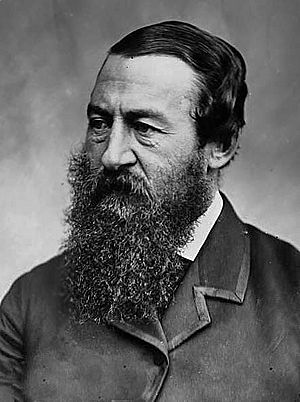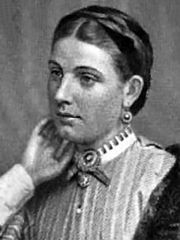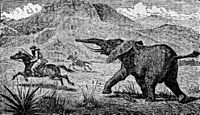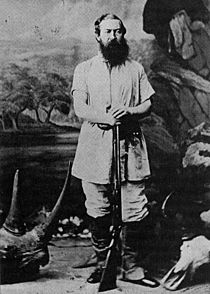Samuel Baker facts for kids
Quick facts for kids
Samuel Baker
|
|
|---|---|
 |
|
| Born |
Samuel White Baker
8 June 1821 London, England
|
| Died | 30 December 1893 (aged 72) Newton Abbot, Devon, England
|
| Resting place | Grimley Saint Bartholomew Church, Grimley, Worcestershire |
| Occupation | Explorer, officer, big game hunter, author, engineer |
| Spouse(s) | Henrietta Ann Bidgood Martin (m.1843–1855, her death) Lady Florence Baker (m.1865–1893, his death) |
| Awards | Fellow of the Royal Society, Patron's Medal and Fellow of the Royal Geographical Society, Grande Medaille d'Or de la Société de Géographie de Paris. Governor-General of Equatoria (1869–1873). President of the Devonshire Association |
| Military career | |
| Nickname(s) | The White Pasha |
| Allegiance | |
| Service/ |
Egyptian Army |
| Rank | Pasha |
| Battles/wars | Ottoman-Egyptian Campaign in Sudan |
Sir Samuel White Baker (born June 8, 1821 – died December 30, 1893) was a famous English explorer, officer, and writer. He was also a naturalist, which means he studied nature, and a big game hunter. He worked as an engineer and was against slavery.
Samuel Baker held important titles like Pasha and Major-General in the Ottoman Empire and Egypt. From 1869 to 1873, he was the Governor-General of a region in Africa called Equatoria. This area is now part of South Sudan and Northern Uganda.
He is best known as the first European to see Lake Albert. He explored the Nile River and parts of central Africa. He was also famous for hunting large animals in Asia, Africa, Europe, and North America. Baker wrote many books and articles about his adventures. He was friends with important people like King Edward VII and other explorers such as Henry Morton Stanley and John Hanning Speke.
Contents
Early Life and Family
Samuel White Baker was born in London, England, on June 8, 1821. His family was wealthy and involved in business. His father, Samuel Baker Sr., was a sugar merchant, banker, and ship owner.
Samuel had several brothers and sisters. His younger brother, Valentine Baker, was also a well-known military officer. Samuel went to private schools in England and finished his studies in Germany. He became a Civil Engineer. He designed railways and bridges in Romania, connecting the Danube River to the Black Sea.
In 1843, Samuel married his first wife, Henrietta Ann Bidgood Martin. They had seven children together. After their wedding, Samuel and Henrietta moved to Mauritius to help with his family's plantation.
Life in Ceylon
In 1846, Samuel and Henrietta moved to Ceylon (now Sri Lanka). The next year, he started a farming settlement in a mountain area called Nuwara Eliya. He brought people and good cattle breeds from England, and the settlement became successful.
During his time in Ceylon, he wrote two books: The Rifle and the Hound in Ceylon (1853) and Eight Years' Wanderings in Ceylon (1855). These books describe his hunting trips in Ceylon. Sadly, in 1855, Henrietta died from typhoid fever. Samuel was 34 years old. Three of their children also died young. Samuel left his four surviving daughters with his sister, Mary.
After Henrietta's death, Baker traveled to Constantinople and the Crimea in 1856. He then worked in Romania again, overseeing the building of a railway and bridges. After that project, he explored parts of southeastern Europe and Asia Minor.
Florence Baker and European Travels
In 1858, Samuel Baker went on a hunting trip with Maharaja Duleep Singh in central Europe and the Balkans. During this trip, in a town called Vidin, Baker met a young woman named Florence. She was born Florenz Barbara Maria in Austria-Hungary (now Romania) around 1841.
Florence became Baker's wife and traveled with him everywhere. They had a wedding ceremony in England in 1865. Florence was very brave and adventurous. She spoke English, Turkish, and Arabic. She rode camels, mules, and horses, and even carried pistols when they were in the wilderness.
The local people in northern Uganda called her Anyadwe, which means Daughter of the Moon, because of her long blonde hair. Florence refused to stay home and always joined her husband on his journeys. She died in 1916 and was buried with her husband in Grimley, England.
Exploring Africa
In March 1861, Samuel Baker began his first big exploration trip in central Africa. His goal was to find the sources of the Nile River. He also hoped to meet other explorers, Captains John Hanning Speke and James Augustus Grant, who were also exploring the Nile.
Baker spent a year near the border of Sudan and Ethiopia. He learned Arabic and explored rivers that flow into the Nile. He proved that the Nile's mud came from Ethiopia. In December 1862, he left Khartoum to follow the White Nile.
Two months later, in a place called Gondokoro, he met Speke and Grant. They had already found the source of the Nile and were traveling down the river to Egypt. Baker was worried there was nothing left for him to discover. However, Speke and Grant gave him information that helped him.
Discovering Lake Albert
After leaving Speke and Grant, Baker became the first European to visit Lake Albert. He first saw the lake on March 14, 1864. He explored the area and showed that the Nile River flowed through Lake Albert.
While there, Baker and his wife were the first Europeans to see a large waterfall on the Victoria Nile. Baker named it Murchison Falls after Roderick Murchison, who was the president of the Royal Geographical Society. After his discoveries, Baker returned to Khartoum in May 1865.
In October, Baker and Florence returned to England. The Royal Geographical Society gave him a special award called the Patron's Medal for his achievements. He was also knighted in August 1866, which means he received the title "Sir."
He published books about his travels, including The Albert N'yanza, Great Basin of the Nile, and Explorations of the Nile Sources (1866) and The Nile Tributaries of Abyssinia (1867). These books were very popular.
Governor of Equatoria
In 1869, the ruler of Egypt, Khedive Ismail, asked Baker to lead a military expedition. The goal was to stop the slave trade in the Nile's equatorial regions and encourage trade and civilization.
Baker started from Cairo with 1700 Egyptian soldiers. He was given the rank of pasha and major-general in the Ottoman army. Lady Baker joined him, as always. The Khedive appointed him Governor-General of the new territory of Equatoria for four years.
Baker faced many challenges, including blockages in the river and opposition from people involved in the slave trade. He also had to deal with armed resistance from local groups. Despite these difficulties, he managed to set up a basic government in the new territory. He returned to Cairo in 1873, and Colonel Charles George Gordon took over his work.
Later Life and Interests
After his time in Africa, Baker wrote a book about his expedition called Ismailia (1874). He also visited Cyprus and wrote about it in Cyprus as I saw it in 1879.
He spent several winters in Egypt and traveled to India, the Rocky Mountains, and Japan. He went on these trips to hunt large animals. In 1890, he published another book called Wild Beasts and their Ways.
Baker was very interested in Egyptian affairs. He believed the British Empire should not give up control of Sudan and later argued for its recapture. He also cared a lot about naval defense and strategy in his later years.
In 1874, he bought an estate in Newton Abbot, England. He died there from a heart attack on December 30, 1893, at the age of 72. His ashes were buried in the Baker family vault in Grimley, Worcestershire.
Hunting Adventures
Samuel Baker was a famous hunter during the Victorian era. He was known for his hunting skills and wrote about his experiences. He was proud of his British background and fought against slavery.
He likely started hunting in Scotland. He was so skilled that he once showed friends how he could hunt a stag with only a knife and dogs. He did the same with wild boars in Ceylon. He continued hunting until his last years, traveling across Europe, Asia, Africa, and North America.
Baker developed his skills hunting Asian elephants and sambar deer in Ceylon. He hunted red stag in Scotland in 1869, and elk, grizzly bears, and buffalo in the Rocky Mountains in 1881. In 1886, he hunted brown bear in the French Alps. He also went to India many times to hunt tigers and blackbuck.
His most famous hunting stories come from Africa and Ceylon. He also hunted in Transylvania for bears, Serbia for wild boars, and Hungary for deer.
Baker studied hunting firearms and wrote about them. He was one of the few hunters to use the two bore rifle, which was a very large gun. His book Wild Beasts And Their Ways (1890) shares his detailed observations of animals.
In 1863, a German zoologist named Theodor von Heuglin named a type of antelope, Baker's antelope, after him. In Sri Lanka, Baker's Falls is named in his honor. In 1906, Luigi Amedeo, Duke of the Abruzzi, named Mount Baker in Uganda after him.
See also
 In Spanish: Samuel White Baker para niños
In Spanish: Samuel White Baker para niños
- List of famous big game hunters




